E. J. Lennox
| Edward James Lennox | |
|---|---|
 | |
| Born |
September 12, 1854 Toronto, Ontario, Canada |
| Died |
April 15, 1933 (aged 78) Toronto, Ontario, Canada |
| Residence | Toronto |
| Nationality | Canadian |
| Other names | E.J. Lennox |
| Occupation | Architect |
| Employer | Self-employed |
| Spouse(s) | Emiline (Wilson) Lennox |
| Children | Eola Gertrude, Edgar Edward, Mabel Emeline, Edith May |
Edward James Lennox (September 12, 1854 – April 15, 1933) was a Toronto-based architect who designed several of the city's most notable landmarks in the late nineteenth and early twentieth centuries including Old City Hall and Casa Loma. He designed over 70 buildings in the city of Toronto.

The son of Irish immigrants, he studied at the Mechanics' Institute where he finished first in his class. Upon graduation in 1874 he apprenticed for architect William Irving for five years. He then formed a partnership with fellow architect William Frederick McCaw, before forming his own firm in 1881.
He quickly became one of the most successful architects in Toronto. He rose to the top of the profession when he won the contract for Toronto City Hall in 1886. His caricature can be seen carved in stone on the facade of the Old City Hall—he's the one with the handlebar moustache.
Many of his buildings were designed in the Richardson Romanesque style, and he was one of the most important figures in bringing that style to Toronto. His creative prowess in the Romanesque Revival style was especially important in The Annex neighbourhood, where Lennox designed the Lewis Lukes House at 37 Madison Avenue in the mid-1880s, pioneering the Annex House. This style of house is indigenous to Toronto and blends elements of Romanesque with that of Queen Anne style architecture.
Later in his career he served as commissioner of the Toronto Transit Commission from 1923-1929.
Buildings
| Building | Location | Dates | Notes | Image |
|---|---|---|---|---|
| Hanlan's Hotel | Toronto Islands | 1875 | Queen Anne; demolished | 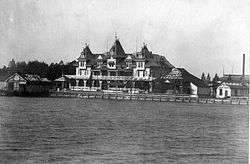 |
| Twenty Plenty outlet | 150 Main Street, Unionville, Ontario | 1879 | Queen Anne; built as Unionville Congregational Church and sold to Presbyterian Church 1894; later used as veterans hall |  |
| Bond Street Congregational Church | Dundas Street and Bond Street (northeast corner) | 1879 | Gothic Revival; Destroyed 1981 (fire, then demolished) |  |
| Berwick Hall | 139 Main Street South, Georgetown | c.1880 | Victorian; Home of local businessman John R. Barber from 1880 to 1904 and since as an apartment building. | |
| Massey Manufacturing Company Office Building | 710 King Street West and 519 King Street West | 1883 | Richardson Romanesque; 710 demolished with 519 now as 511 King Street West and houses offices and retail tenants | |
| Lewis Lukes House | 37 Madison Avenue, The Annex | 1886 | Richardsonian Romanesque; Converted to office space (Maverick Public Relations Inc) | |
| Milburn Building | 47-55 Colborne Street | 1886 | Richardson Romanesque; lower floor restaurants and upper floor offices |  |
| Massey Mausoleum | Mount Pleasant Cemetery | 1892 | Richardson Romanesque | |
| Toronto Athletic Club | 149 College Street at University Avenue, Toronto | 1894 | Richardsonian Romanesque; now Rotman School, University of Toronto | |
| Beard Building | King Street East and Jarvis Street, Toronto | 1894 | Richardsonian Romanesque; demolished in the 1930s | 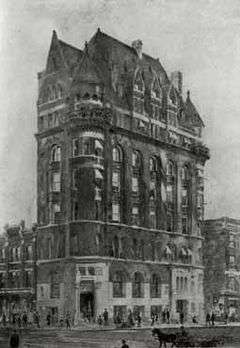 |
| Georgetown High School | Georgetown, Ontario | 1899 | Demolished 1959 and replace with current building 1960 (now Georgetown District High School) | |
| Freehold Loan Building | Adelaide Street East at Victoria Street, Toronto | 1890 | demolished 1960s; now 20 Adelaide Street East c 1988 |  |
| Broadway Methodist Tabernacle | College Street and Spadina Avenue, Toronto | 1899 | Richardsonian Romanesque; demolished c. 1930 | 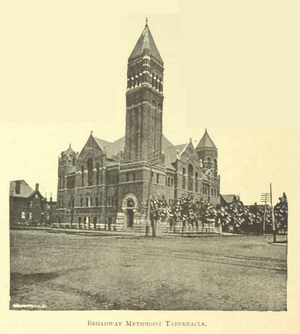 |
| Old City Hall | Queen Street West and Bay Street, Toronto | 1899 | Richardsonian Romanesque; now provincial court house | 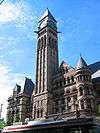 |
| King Edward Hotel | King Street East and Jarvis Street, Toronto | 1903 | Chicago School; Designed with Henry Ives Cobb for George Gooderham’s Toronto Hotel Company[1] | |
| Toronto-Bridgman Transformer Station | 391 Davenport Road | 1904 | Toronto Hydro Transformer Station | |
| Bank of Toronto | Yonge Street and Queen Street | 1905 | Neo-Classical |  |
| West Wing of the Ontario Legislative Building at Queen's Park | Queen's Park Crescent, Toronto | 1909 | Edwardian Neoclassical architecture to interior and additional floor on West Wing | 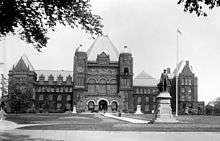 |
| Casa Loma | 1 Austin Terrace, Toronto | 1911 | Gothic Revival | |
| Toronto Power Generating Station | Niagara Falls, Ontario | 1906 | Neo-Renaissance | 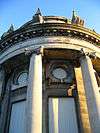 |
| St. Paul's Anglican Church | 227 Bloor Street East | 1913 | Richardsonian Romanesque | |
| Postal Station G | South Riverdale, Toronto | 1913 | Neo-Classical; today the Ralph Thornton Community Centre | |
| Lenwil | 5 Austin Terrace | 1913 | Tudor Revival architecture; Built by Lennox as his own residence and today is the provincial home of the Sisters Servants Of Mary Immaculate | |
| Excelsior Life Insurance Company Building | 36 Toronto Street | 1914 | Beaux-Arts; Currently used as office and commercial space | |
| Wolseley Motor Car Company | 77 Avenue Road | 1914 | Richardsonian Romanesque; demolished 1976 and now part of Hazelton Lanes complex | |
| Toronto Western Hospital | 399 Bathurst Street | Neo-Renaissance; 1906 (North Wing), 1910 (South Wing), 1911 and 1923 (additions) | Demolished 1950s-1992; now parking lot | |
| Residence for James B. Boustead | 134 Bloor Street East | 1891 | Tudor Revival; Built for James Bellingham Boustead, Toronto entrepreneur and Toronto alderman 1865-1897; demolished mid-20th Century and near the site of the Manulife Insurance Building |
Legacy
A small residential street called E.J. Lennox Way is named for him in Unionville, Ontario behind the former Unionville Congregational Church.
Notes
References
| Wikimedia Commons has media related to E.J. Lennox. |
- Lennox, Edward James. The Canadian Encyclopedia.
- Litvak, Marilyn M. Edward James Lennox: Builder of Toronto